This comprehensive introduction to Cow's Milk Protein Allergy (CMPA) was written by Paula Hallam, a specialist paediatric dietitian.
What is Cow's Milk Protein Allergy?
Cow’s milk protein allergy (CMPA) is the most common food allergy in babies and young children. The prevalence of CMPA varies between 2 and 7.5% of babies during the first year of life. CMPA most often presents with symptoms within the first 6 months of life and rarely presents after 12 months of age. It is more common in formula fed babies but can still occur in breastfed babies.
CMPA occurs when the body’s immune system mistakenly recognises the proteins found in cow’s milk as harmful and goes into “defence mode” by producing an allergic response which is seen as many symptoms (see table below). CMPA can present as an immediate (IgE mediated) or delayed (non-IgE mediated) allergy or a ‘mixed’ picture of both of these presentations.
The outlook for children with CMPA is very positive with most children growing out of their CMPA, although the age at which this occurs is highly variable. Approximately 75% of children with CMPA will grow out of their allergy by 3 years of age and 90% will have outgrown it by 6 years of age. However, a small percentage of CMPA persists until adulthood.
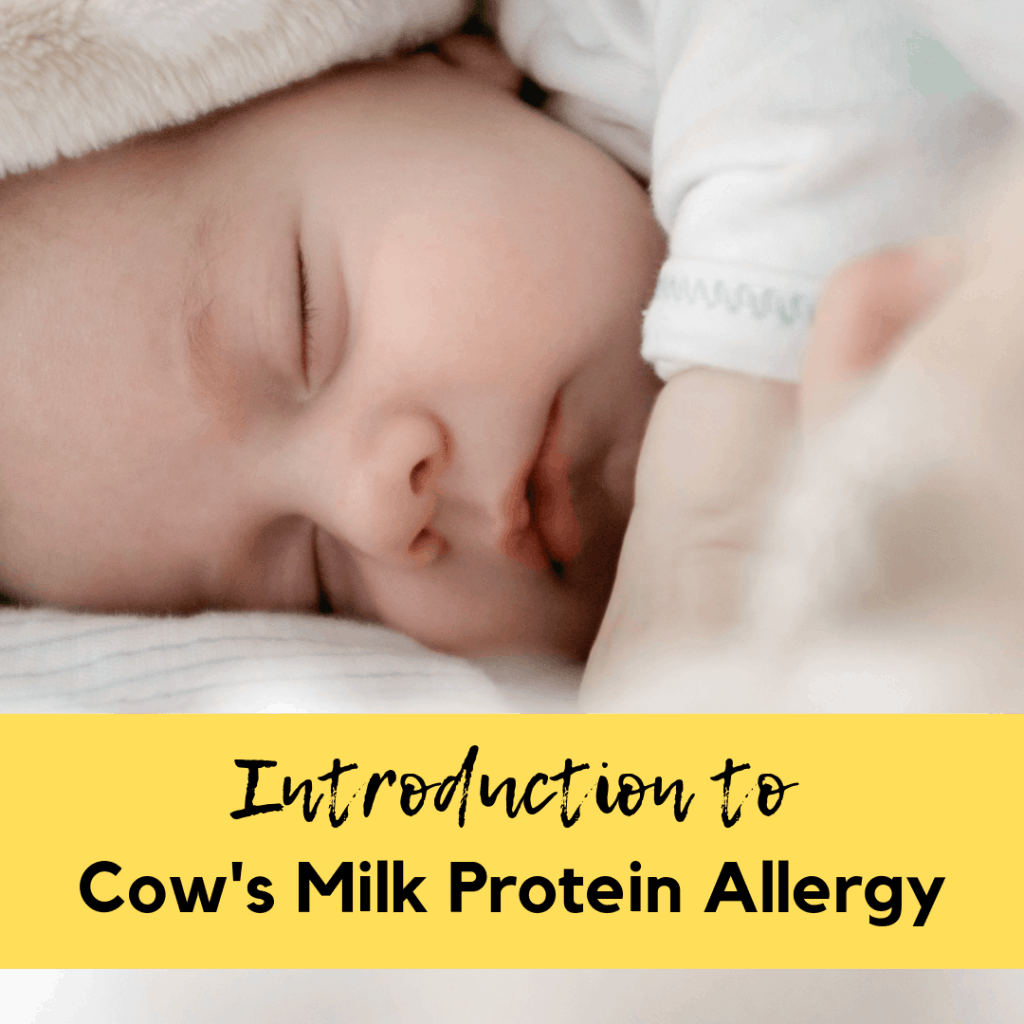
Photo by Peter Oslanec on Unsplash
Symptoms of Cow's Milk Protein Allergy
CMPA should be suspected in infants or children who have one or more of the signs and symptoms described in Table 1 (NICE CKS 2015).
Table 1
| IgE-mediated CMPA | Non-IgE-mediated CMPA |
| Speed of onset of symptoms | |
| Acute and has a rapid onset (up to 2 hours after ingestion) | Non-acute and generally delayed (manifest up to 48 hours after ingestion) |
| Skin reactions | |
| Pruritus (itching) | Pruritus |
| Erythema (redness) | Erythema |
| Acute urticaria – localised or generalised | Atopic eczema |
| Acute angioedema – most commonly of the lips, face and around the eyes | |
| Gastrointestinal symptoms | |
| Angioedema of the lips, tongue and palate | Gastro-oesophageal reflux disease |
| Oral pruritus | Loose or frequent stools |
| Nausea | Blood and/or mucus in stools |
| Colicky abdominal pain | Abdominal pain |
| Vomiting | Infantile colic |
| Diarrhoea | Food refusal or aversion |
| Constipation | |
| Perianal redness | |
| Pallor and tiredness | |
| Faltering growth in conjunction with at least one or more gastrointestinal symptoms above (with or without significant atopic eczema) | |
| Respiratory symptoms (Usually in combination with one or more of the above symptoms and signs) | |
| Upper respiratory tract symptoms (nasal itching, sneezing, rhinorrhea or congestion, with or without conjunctivitis) | Asthma |
| Lower respiratory tract symptoms (cough, chest tightness, wheezing or shortness of breath) | |
| Other | |
| Signs or symptoms of anaphylaxis or other systemic allergic reactions |
How is Cow's Milk Protein Allergy managed or treated?
Management involves the complete avoidance of all foods containing cow’s milk protein for a period of time – usually at least 6 months from diagnosis or until around 12 months of age.
The proteins in cow’s milk are called whey and casein. Other mammalian milk proteins, such as goat or sheep milks should also be avoided, as proteins are up to 90% similar to cow’s milk proteins.
Guidelines recommend that a baby with CMPA should be re-evaluated by an allergy specialist every 6-12 months to check if they have grown out of their allergy.
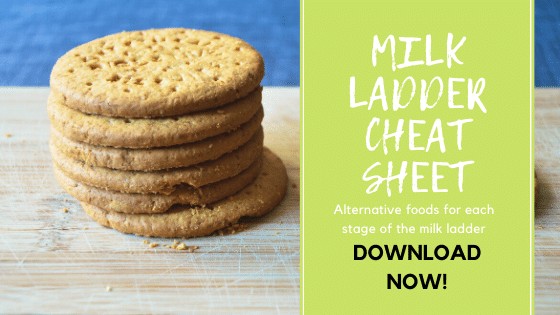
What about soya and CMPA?
Some children with CMPA can tolerate soya and the likelihood of this depends on the type of CMPA a baby has – delayed onset or immediate onset.
Up to 50-60% of babies/children with delayed type CMPA may also react to the soya protein with similar symptoms, which are usually gut-related symptoms such as abdominal pain, vomiting, diarrhoea, constipation or blood in the stools in an otherwise well child.
Interestingly only around 10% of babies with immediate type CMPA react to the soya protein. So fortified soya products can be a nutritious option for children with immediate onset or IgE mediated CMPA, if tolerated.
However, soya infant formula is not recommended in the UK before 6 months of age due to the plant oestrogen content. If soya is tolerated, soya infant formula can be introduced after the age of 6 months and fortified soya and other plant-based drinks can be introduced in foods (NOT as a main drink) from 6 months of age. In addition, other fortified soya products such as yoghurts and cheese can also be included in the diets of children who tolerate soya protein from 6 months of age.
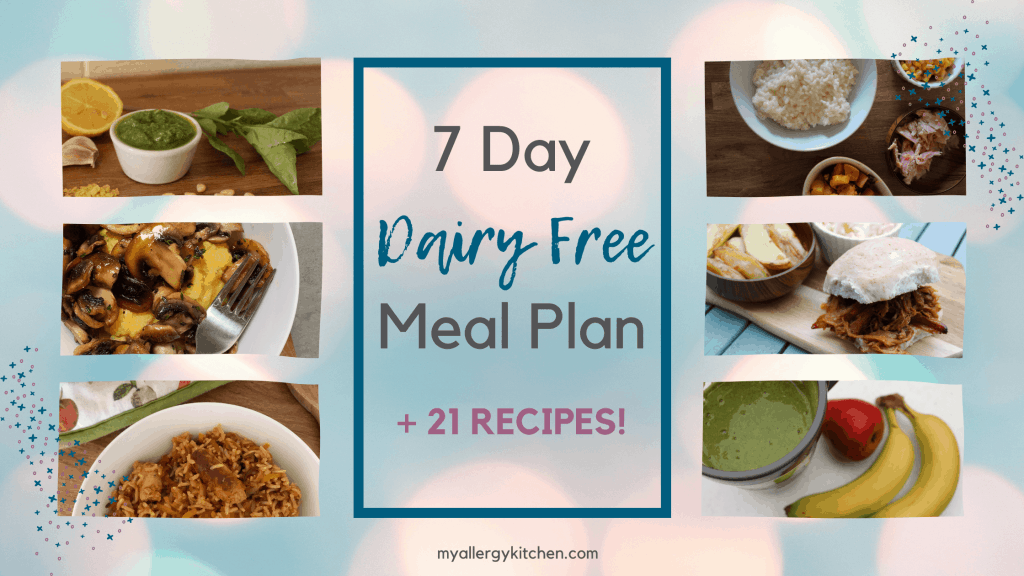
What if my child needs to avoid dairy AND soya products?
As an infant, and often up to the age of 18 months to 2 years, depending on their growth and nutritional needs, your child will be prescribed a ‘hypoallergenic formula’ also known as an extensively hydrolysed formula (EHF) or an amino acid formula (AAF) if the EHF is not tolerated.
There are many plant-based drinks available, but they are not all suitable for babies and young children*. Additionally, there are also many non-dairy sources of calcium and I have added a table at the end of the blog post to summarise these. I have also written more about plant-based drinks on my blog (https://tinytotsnutrition.co.uk/childrens-nutrition-blog/)
*REMEMBER: Rice milk is not suitable for children under the age of 5 years due to the arsenic content
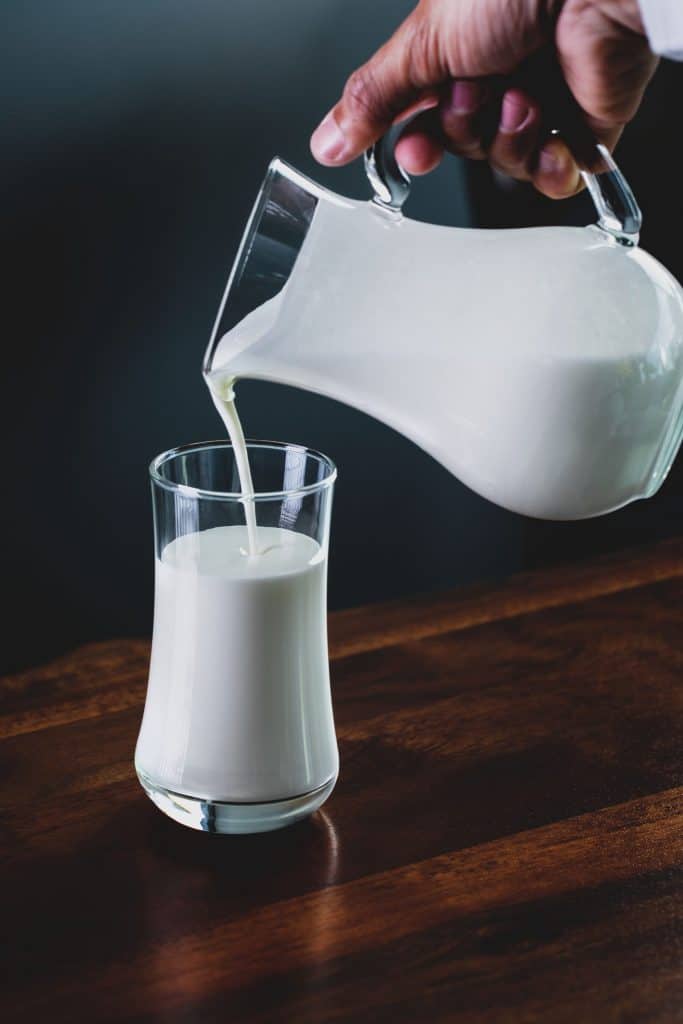
Photo by Eiliv-Sonas Aceron on Unsplash
Breastfeeding and Cow's Milk Protein Allergy
Breast milk is the ideal source of nutrition for all babies, including those with CMPA. Breastfeeding mums should be supported and encouraged to continue breastfeeding for as long as they would like to, preferably until 2 years of age, as recommended by the World Health Organisation (alongside the introduction of solids from around 6 months of age).
CMPA can occur in breastfed babies but it is much less common than in formula fed babies. 0.5% of exclusively breastfed babies show reactions to cow’s milk protein compared to 2-7.5% of formula fed babies. It is thought that immunomodulators present in breast milk and differences in the gut bacteria of breastfed and formula fed infants may contribute to this.
In addition, the level of cow’s milk protein present in breast milk is 100,000 times lower than that in cow’s milk. This means that not all breastfeeding mums need to restrict dairy products from their diet, as some babies with CMPA only react to dairy products given to them in their own diet.
Diagnosing CMPA in Breastfed Babies
In order to prove/disprove a delayed type allergy to cow’s milk of an exclusively breast fed baby, a trial elimination of dairy products (for mum) for 2 to 4 weeks is recommended and then a reintroduction to see if symptoms return (or not). The MAP guideline has an excellent algorithm to explain this (there is a link on the Allergy UK website).
If a mum needs to exclude dairy products from her diet, it is really important that mums are supported to help them maintain a good nutritional intake to support breastfeeding for as long as they wish to continue, preferably until 2 years of age as recommended by the World Health Organisation.
For instance, fortified alternatives to dairy/soya milk, yoghurt and cheese can be very useful for breastfeeding mums to meet her nutritional requirements. However, she may need supplementation if she cannot meet her nutritional requirements of 1250mg calcium, 10ug vitamin D per day and 250ug iodine per day (ask a Registered Dietitian for help with this)
Breast milk alternatives
If you need to give formula milk in addition to breast milk or as an alternative, a range of hypoallergenic formulas especially designed for infants with cow’s milk protein allergy (CMPA) are available on prescription. These are extensively hydrolysed formulas and amino acid formula.
Extensively Hydrolysed Formulas
These formulas contain proteins that have been broken down (hydrolysed) into smaller segments so that the body does not recognise them as allergens. Therefore this type of formula is very unlikely to cause an allergic reaction.
There are different types of these formulas. Some are based on whey and others are based on casein, which are both proteins found in cow’s milk. In addition, some hydrolysed formulas contain lactose and some do not. The majority of children with CMPA (90-95%) will tolerate an extensively hydrolysed formula.
Amino Acid Formulas
These formulas are based on the individual building blocks (amino acids) that make up a protein and are used for children with severe CMPA that still have have symptoms on extensively hydrolysed formulas.
Getting enough calcium on a dairy free diet
In addition to the information below, I have written a detailed blog post all about how to make sure your child is getting enough calcium on a dairy free diet (see https://tinytotsnutrition.co.uk/childrens-nutrition-blog/)
Table 2: UK daily calcium requirements
| Age | Calcium per day (mg) |
| 0-12 months | 525mg |
| 1-3 years | 350mg |
| 4-6 years | 450mg |
| 7-10 years | 550mg |
| 11-18 years | 1000mg (boys) 800mg (girls |
| Breastfeeding mums | 1250mg |
Important non-dairy sources of calcium:
- Fortified soya products (if tolerated) such as soya milk or yoghurt
- Fortified oat-based cereals – such as Ready Brek, Ready Oats (Sainsbury’s), Super Smooth Porridge (Tesco)
- Other fortified breakfast cereals such as Cheerios, Alphabites, Rice Krispies (check labels)
- Fish with soft bones that can be eaten - such as tinned sardines, anchovies, salmon, pilchards and whitebait
- Certain fruits and dried fruit – such as dried apricots, dried figs, currants and oranges
- Certain vegetables – such as okra, kale, broccoli, cabbage
- Nuts and spreads - such as peanut butter, almond butter, hummus and tahini paste (sesame seed paste)
Please note:
Due to high levels of oxalates, which inhibit the absorption of calcium, in some vegetables particularly spinach, rhubarb, beet greens and certain beans, it is not advisable to rely on vegetables alone to meet your child’s calcium needs.
Dairy alternatives
There are also many dairy alternatives to yoghurt and cheese, which can be very helpful in meeting the calcium needs of young children. Always make sure that the product is fortified with calcium and in particular remember that organic varieties are not fortified. Some fortified examples include:
- Oatly creamy oat fraiche (100g = 120mg calcium)
- Koko dairy free plain yoghurt (100g = 160mg calcium)
- Alpro simply plain soya yoghurt (100g = 120mg calcium)
- Koko dairy free cream cheese (50g = 100mg calcium)
(I have included a detailed table at the end of the blog post).
Iodine and CMPA
A recent study in Norway looking at iodine status of children under 2 years of age with CMPA found that 30% had iodine deficiency. Additionally, they found that in the breastfed group, there was a higher prevalence of iodine deficiency than in the group who were fed hypoallergenic formula. Breastfed infants are highly dependent on the content of iodine in breast milk, which in turn is dependent on the breastfeeding mother’s iodine status. In other words, breastfeeding mothers must ensure their iodine intake is sufficient.
Why is Iodine important?
Iodine is an essential micronutrient but not one you often hear about. It is only needed in tiny quantities (50 – 130 micrograms per day, depending on the age of the child and 200 micrograms per day for pregnant and breastfeeding mums), but it has an essential role to play in helping our bodies to make thyroid hormones.
Iodine is also essential in pregnant women to support baby’s brain and neurological development. Recent research has shown that there has been a re-emergence of iodine deficiency in the UK and this is particularly important in pregnant women, where a deficiency of iodine could influence the neurodevelopment of their children.
Food sources of iodine
The best sources of iodine are found in dairy products, eggs and in sea fish (particularly white fish) and shellfish. For this reason, dairy-free diets can be low in iodine and vegan diets can be very low in iodine. Check with your healthcare professional, as some children and breastfeeding mums may need to take an iodine supplement, but be careful, as very high intakes of iodine can be harmful.
The BDA has a very helpful factsheet on Iodine (https://www.bda.uk.com/foodfacts/Iodine.pdf)
Dairy free milk alternatives that contain iodine, as well as calcium and vitamins:
- Koko ‘super’ coconut milk
- M&S oat drink
- ASDA free from oat drink
- Alpro soya growing up drink 1-3 years
Table 3: Non-dairy sources of calcium:
(Credit: Adapted from BDA Food Allergy Specialist Group - Cow’s milk free diet for infants and children 2019)
| Product | Quantity | Calcium (mg) |
| Calcium-fortified products | ||
| Hypoallergenic infant formula E.g. Nutramigen with LGG, Aptamil Pepti 1, Alimentum, Neocate LCP, Neocate Syneo, Nutramigen Puramino, SMA Alfamino | 100ml | 47-90 |
| Hypoallergenic follow on formula (from 6 months of age) E.g. Nutramigen 2, Aptamil Pepti 2, Neocate Junior (only from 1 year +) | 100ml | 60-95 |
| Wysoy (soya infant formula) | 100ml | 67 |
| Calcium-enriched milk alternatives e.g. Soya, oat, nut, coconut, | 100ml | 120 |
| “Extra” calcium-fortified milk alternatives E.g. Califia Almond, Koko coconut super milk, The Mighty Society pea milk | 100ml | 170 |
| Calcium-fortified cheddar cheese alternatives E.g. Koko cheddar Tesco free from cheddar | 30g 30g | 220 45 |
| Calcium-fortified soft cheese alternatives E.g. Koko cream cheese Tesco free from soft cheese | 30g 30g | 60 45 |
| Calcium-fortified soya or coconut yoghurt, desserts E.g. Alpro, Oatly crème fraiche, supermarket own brands | 100g | 96 - 160 |
| Calcium-fortified hot oat cereal E.g. Ready Brek, supermarket own brands | 15g (1 tablespoon dry cereal) | 200 |
| Calcium-fortified cereals E.g. Rice Krispies, Cheerios, Alphabites multigrain cereal | 30g | 136 - 174 |
| Calcium-fortified breads E.g. Hovis Best of Both Kingsmill 50/50 Vitamin Boost | 1 slice 1 slice | 191 150 |
| Soya bean curd (tofu) – ONLY if set with calcium chloride (E509) or calcium sulphate (E516) not Nigari | 60g | 200 |
| Non-fortified products | ||
| Sardines (with soft bones) | ½ tin (60g) | 260 |
| Pilchards (with soft bones) | 60g | 150 |
| Tinned salmon (with soft bones) | 55g | 60 |
| White bread | 1 slice | 50 |
| Wholemeal bread | 1 slice | 27 |
| Orange | 1 medium | 75 |
| Broccoli | 2 spears (85g) | 34 |
| Okra | 5 okra fingers | 120 |
| Kale | 20g | 30 |
| Dried figs | 3 | 150 |
PLEASE NOTE: Some foods such as spinach, beans, dried fruits, seeds and nuts also contain calcium but it is not absorbed very well as they contain phytates or oxalates which decrease the absorption of calcium. They are still nutritious foods to include, but should not be relied upon as the MAIN source of calcium in the diet.

Paula Hallam RD, PG Cert (Paed Diet)
Specialist Paediatric Dietitian
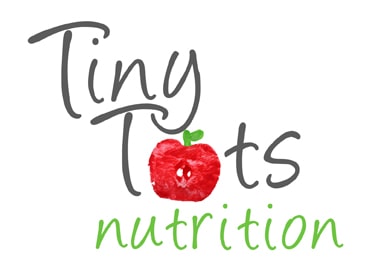


[…] Fonte: https://www.myallergykitchen.com/2019/05/29/introduction-to-cows-milk-protein-allergy/ […]